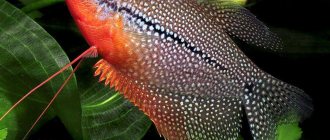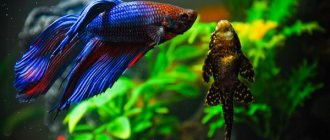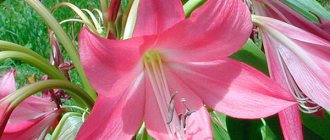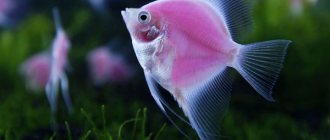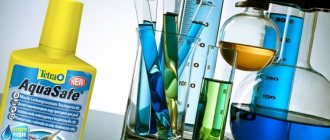- Determine the correct volume
- Choose food
- Maintain temperature conditions
- Change the water correctly
- Install a filtration system
- Monitor the oxygen level in the water
- Create conditions for reproduction
- Install the right lighting
- Prepare the right fauna for the fish
- Purchase chemicals and equipment for cleaning the aquarium
Not at first glance, aquarium fish are absolutely problem-free animals that do not require careful care.
Beginner aquarists mistakenly think that it is enough to add food and periodically completely change the water. But in practice, you change the water, add food, and your pet fish become dull, look bad, are not active, become covered with wounds, or even die. We have prepared 10-point instructions on how to properly care for fish in an aquarium:
Determine the correct volume
It sounds trivial, but each type of fish has its own need for free space. A small aquarium at the rate of 1 liter of water per adult will suffice for a cockerel, zebrafish or guppy, but a goldfish will not live long in a confined space. Before moving in, read the description of the breed and the required conditions for keeping it on the Internet.
The following signs indicate a lack of space in the aquarium:
- rot appeared on the fins;
- the fish are lethargic and refuse food;
- the inhabitants of the tank look dull and shabby;
Also, with an acute shortage of space, fish die or acquire an unnatural curvature of the spine.
Plants
Some aquarists prefer artificial plants. Yes, there is no hassle with them, you just have to clean them of plaque a couple of times a year, but there will be no benefit from such plants either, but there is a lot of benefit from the “natural product”. It’s not for nothing that living vegetation is called the “lungs” of an aquarium - it really releases oxygen, and some specimens also serve as food for fish, as well as a place for spawning.
The hardiest grass is Vallisneria. It takes root without problems, grows quickly, and is unpretentious in care. Thin long light green leaves of Vallisneria perfectly drape the back wall of the tank. Ludwigia repens, bacopa, and rotalla are good for the middle part. You can also put a piece of driftwood with Java moss.
Choose food
Food for aquarium inhabitants can be of several types:
- dry - available in flakes or granules, you need to select it depending on the structure of the mouth of the underwater inhabitant;
- natural – frozen, gelled and live food
- additives - vitamin supplements help bright fish maintain their colors and grow healthy fins;
How to feed fish in an aquarium correctly, and most importantly, how often?
Adult goldfish, bettas and guppies need to be fed no more than twice a day, and fry - about four. Otherwise, they will not eat all the food; it will sink to the bottom and become an excellent breeding ground for harmful bacteria. Plus, overfed fish become fat, get sick and reproduce worse. Important to know: Choose live food carefully. It is extracted from natural reservoirs and may contain harmful substances and pathogens. Buy from a trusted manufacturer and thoroughly rinse the food before feeding or keep it in the freezer.
Siphonim soil
After all the operations performed, a lot of turbidity and dirt rises from the bottom, and a hose or siphon is used to remove this obscenity.
What is needed for this procedure?
In a specialized store you can purchase a special device - a cylinder with a hose and a funnel at the end. Select the diameter of the hose according to the size of the debris: it should pass freely along with the liquid. Using a siphon, you can remove detritus and other dead particles from the bottom surface, as well as drain the soil.
So, in addition to the siphon, you also need a bucket. Preferably white, so that if a fish gets into the funnel, you can see it immediately. Remove remaining food, waste and mulch along with a quarter of the water. You need to stick the funnel into the ground several times to remove all the dirt.
Do not stir up the soil too much. This can lead to fish diseases due to problems in the normal functioning of the substrate, which processes organic matter. The reason lies in the fact that the soil surface is covered with special aerobic microorganisms that contribute to the correct progression of the nitrate cycle. It is the top layer of soil that contains oxygen, which plays a decisive role in the life of these microorganisms
In addition, any careless intervention in the structure of the soil entails a lot of difficulties with dangerous chemical compounds
How do you know when it's time?
Move a couple of pebbles at the bottom and see if air bubbles rise from the bottom. If there are few or none at all, then cleaning the bottom can be postponed. But if there are a lot of bubbles and in addition to them you also observe dark silt and turbidity, then during cleaning it is sometimes necessary to immerse the siphon in the ground.
Typically, excrement and uneaten food do not penetrate into the lower layers of the substrate, of course, if the size of the soil is selected correctly. However, if the waste has penetrated deep enough or the cleaning has not been carried out for too long, a strong process of rotting can begin, causing the water to be filled with dangerous hydrogen sulfide.
In such a situation, aquarium owners say that the substrate has turned sour. It’s easy to verify this: turn over a few pebbles at the bottom, and if you smell the characteristic smell of rotten eggs, you should immediately begin general cleaning. Sometimes this happens because the soil has compacted and begun to rot. This happens due to insufficient water circulation at the bottom. Make sure that algae does not occupy the entire surface of the soil, otherwise it will have to be subjected to heat treatment. Essentially, this is starting from scratch. Therefore, in order not to turn maintaining an aquarium at home into complete torture, carefully monitor the condition of the soil.
Maintain temperature conditions
Aquariums, depending on the inhabitants, are either cold-water or warm-water. Accordingly, you will have to maintain a comfortable water temperature for a particular species. A sharp change of 3-5 degrees will greatly affect the activity and well-being of the inhabitants of the tank. The optimal water temperature for most fish, with the exception of discus, angelfish and pure black fish, is considered to be between +23-24 degrees Celsius.
When hypothermia occurs, fish slow down, become sleepy and apathetic. When overheated, they become unnaturally bright and often sit on surfaces and greedily swallow air.
To maintain the temperature regime, you need to choose a thermometer and special heating for the aquarium.
Good nutrition is the key to health
Many people think that the instructions for feeding fish are quite simple? By and large, this is true. After all, what could be difficult about feeding your little friends daily, regularly and in a timely manner? First of all, it is recommended to develop a conditioned reflex in them to swim up to the surface of the aquarium and lightly tap the edge of their nail on the glass. But you should also take into account the fact that some fish can become so accustomed to following the regime that they can independently swim up to get their food at the same time.
As for the diet, it is necessary to take into account the characteristics of the selected fish. Many people recommend using dry and frozen food mixed with vegetable and bloodworms. But real professionals urge you to refrain from doing this. It is better to use frozen bloodworms, which are excellently digestible by most inhabitants of the aquatic depths.
And the most important thing is not to overdo it in feeding. It seems that it is very simple, but sometimes it is so difficult to stop, looking at how enthusiastically they eat food. This is why most young aquarists begin to try to get a little more sleep, thereby causing unintentional but serious harm to the inhabitants of the aquarium.
The fact is that frequent overeating in fish significantly reduces life expectancy. An excellent indicator of the health of fish is their behavior. As soon as it changes for the worse, this is an alarm bell indicating that their food should be cut back a little, or better yet, left to starve for a while.
Change the water correctly
Inexperienced aquarists often completely change the water in the aquarium at the slightest cloudiness. This is fraught with the complete destruction of the ecosystem created in the tank, and each time you have to start the aquarium anew and again adapt the inhabitants to new living conditions.
How to change the water in a fish aquarium? Depending on the type of fish and the severity of the contamination, it is recommended to regularly drain about a third of the total volume of water and add fresh water. This is a universal tip for use in a round aquarium, rectangular and any other shaped tank.
Accessories
Sometimes the glass tank comes complete with cabinets and lids with built-in lighting. This option is useful if there is no space to install the vessel. The cabinet is designed to support the weight of a water container, and there are compartments for storing aquarium accessories. The lid is convenient because it prevents fish from jumping out and relieves the aquarist from the inconvenience associated with installing lighting.
Install a filtration system
A properly selected artificial filtration system will help keep water clean longer and prevent the growth of harmful bacteria.
Natural filters such as Siamese algae eaters, otocinclus, ancistrus, shrimp and neretina snails will help maintain a healthy ecosystem and extend the time between cleaning the aquarium. The latter are unpretentious and do an excellent job of cleaning the aquarium from soft waste, algae on the walls, plants and decor. The only disadvantage of snails is their high reproduction rate.
What do water parameters depend on?
The amount of certain substances in H2O directly affects its performance:
- smell - depends on the amount of bleach and the quality of wastewater treatment;
- color – a yellowish tint indicates a large amount of organic impurities;
- transparency - cloudiness of water occurs from a high level of solid chemical impurities;
- acidity – indicates the level of hydroxide, acids and salts;
- hardness - depends on the amount of calcium, magnesium and heavy metals;
- temperature – associated with the proliferation of bacteria and protozoa;
- gases – detects the presence of oxygen, hydrogen sulfide and carbon dioxide.
Monitor the oxygen level in the water
Remember, the fish will not be able to live in water with severe oxygen deficiency! Of course, there are deep-sea species in the ocean that do not require oxygen in the water. But they will not be able to survive in a simple aquarium, without creating the necessary lighting and pressure.
Therefore, be sure to choose the appropriate size aerator. Remember that it should not be too powerful, otherwise the inhabitants of the tank will be carried around in a circle, like on a carousel.
Important: If there are algae in the aquarium, be sure to turn on the aeration at night. Some varieties of underwater plants produce carbon dioxide at night and without an aerator the fish can suffocate.
Why is it worth getting into aquarium farming?
Fish breeding is not just a fun activity. This is a form of recreation, and professionals can count on a good, stable income by selling ornamental fish, servicing aquariums and consulting for hobbyists.
It is useful to involve children in aquarium hobby. Taking care of fish will help develop such qualities as responsibility, accuracy, and attentiveness.
Previous
AquariumHow to start an aquarium correctly: 10 steps and recommendations from experts
Next
AquariumHow to use Tetra Algumin Plus
Create conditions for reproduction
The fish can be viviparous or spawn-bearing. In both cases, it is necessary to create special conditions to protect the female and her offspring from relatives. For viviparous fish, you can set up a separate tank inside or outside the aquarium, and before giving birth, use a net to move the female there.
Egg-laying fish need special soil and algae on the bottom so that they can hide the eggs before the fry hatch.
Diseases and prevention
Most aquarium fish have strong immunity. The main causes of diseases in aquarium fish are:
- deterioration of water quality;
- infection;
- severe contamination and an increase in the number of pathological bacteria.
If, when examining fish, you see passive fish lying on the bottom, moving strangely, with strange spots or plaque on the body or fins, look for the reason. If necessary, accommodate separately.
Install the right lighting
Good lighting in the aquarium affects the growth rate, well-being of the fish and the survival of their offspring. Choose the right light and you will get large, beautiful and well-developed individuals. But natural lighting alone is not enough; you need to buy special equipment.
Today on the aquarium market there are lamps that not only provide light, but also disinfect water using ultraviolet light.
Choose the right fish for your aquarium
The choice of fish for novice aquarists should be conscious. It should not be based solely on their appearance. For beginners, it is better to choose unpretentious individuals that do not require serious personal care. If you buy too expensive and whimsical fish, then there is a high probability that your first experience will be unsuccessful, because in the first couple it is difficult to avoid mistakes. It would be a good idea to ask the seller about the specifics of caring for a particular type of fish.
There is an important rule - all aquarium fish that you plan to keep in a closed ecosystem must have the same requirements for feeding and water quality. It is advisable to select individuals of approximately the same size and temperament.
When purchasing, it is important to inspect the fish. Any damage, wounds, or problems with scales are a sure sign that you don’t need to buy them. It is better to take non-mature individuals, which are better adapted to changes in habitat.
Prepare the right fauna for the fish
Algae in an aquarium is not just a beautiful background, but an additional source of nutrition and a necessary condition for the survival of fish. When choosing, we recommend following the rule “more plants, fewer varieties.” This will make caring for them easier. Additionally, be guided by the height of the adult plant and its location in the aquarium.
Equipment
To keep fish comfortable in an aquarium, purchase the necessary equipment. Equipment providing main functions:
- Internal filter. Suitable for a small aquarium. Filters water, preventing cloudiness and stagnation. Before purchasing, read the instructions, which outline the characteristics of the device and operating rules.
- External filter. External devices are more expensive. Filter the liquid in larger tanks.
- Compressor for saturating water with oxygen. Provides a comfortable existence for the fish.
- Thermometer. Allows you to monitor the temperature.
- Temperature regulator. Heaters with pond coolers are especially useful on hot or cold days.
- Lamp. Plants need lighting more than fish. The light will ensure normal growth of aquarium flora and imitate the natural habitat.
